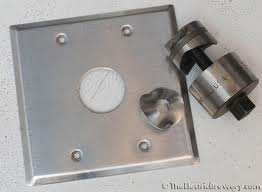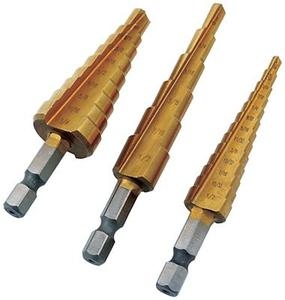Difference between revisions of "Drilling Sheet Metal"
| Line 3: | Line 3: | ||
[[File:Whitney sheet metal punch.jpg]] [[File:Chassis punch.jpg]] | [[File:Whitney sheet metal punch.jpg]] [[File:Chassis punch.jpg]] | ||
| − | Since it is not always practical to have all of the punches you need, we will talk here about drilling with a regular twist drill, which is tricky, and can be '''dangerous'''. | + | Since it is not always practical to have all of the punches you need, we will talk here about drilling with a regular twist drill, which is tricky, and can be '''dangerous'''. The most dangerous part of drilling in sheet metal is that it is thin and the drill can, and usually does, slice into the metal, transferring most of the torque to the work. Sheet metal must be very strongly clamped to keep this torque from turning the work into a spinning knife, which can inflict serious damage to your body. |
==Step Drills== | ==Step Drills== | ||
| − | + | One way to drill sheet metal with with a special drill called a "step drill" or a "uni-bit." These are single flute drills specifically designed for cutting sheet metal by starting with a small hole and progressively enlarging it to your final desired size. This kind of drills does not pull the drill into the metal, but relies on you to push into the metal to the desired depth/diameter. A step drill should be run a slow to moderate spindle speed or it will chatter. If you are using a hand held machine, having a side handle reduces the tendency for the machine to twist out of the hand. A drill press is recommended. Make sure the material is well clamped a close to the drilling area as possible, and that there is a place for the drill to go as it cuts through. | |
| + | |||
| + | [[File:Step drills.jpg]] | ||
| + | |||
| + | ==Hole Saws== | ||
| + | You can cut sheet metal with a hole saw | ||
Revision as of 00:07, 9 September 2011
Sheet metals present a special challenge for drilling. The best way to drill in sheet metal is not to drill at all, but the use a punch. A sheet metal punch is basically a round shear. It pushes the part you want removed into a sharp edged hole of the same size and shape, cleanly shearing the hole. A couple of examples are shown below, a Whitney punch and a chassis punch. With a chassis punch, you need to start with a smaller hole for the bolt on the punch to go through.
Since it is not always practical to have all of the punches you need, we will talk here about drilling with a regular twist drill, which is tricky, and can be dangerous. The most dangerous part of drilling in sheet metal is that it is thin and the drill can, and usually does, slice into the metal, transferring most of the torque to the work. Sheet metal must be very strongly clamped to keep this torque from turning the work into a spinning knife, which can inflict serious damage to your body.
Step Drills
One way to drill sheet metal with with a special drill called a "step drill" or a "uni-bit." These are single flute drills specifically designed for cutting sheet metal by starting with a small hole and progressively enlarging it to your final desired size. This kind of drills does not pull the drill into the metal, but relies on you to push into the metal to the desired depth/diameter. A step drill should be run a slow to moderate spindle speed or it will chatter. If you are using a hand held machine, having a side handle reduces the tendency for the machine to twist out of the hand. A drill press is recommended. Make sure the material is well clamped a close to the drilling area as possible, and that there is a place for the drill to go as it cuts through.
Hole Saws
You can cut sheet metal with a hole saw


